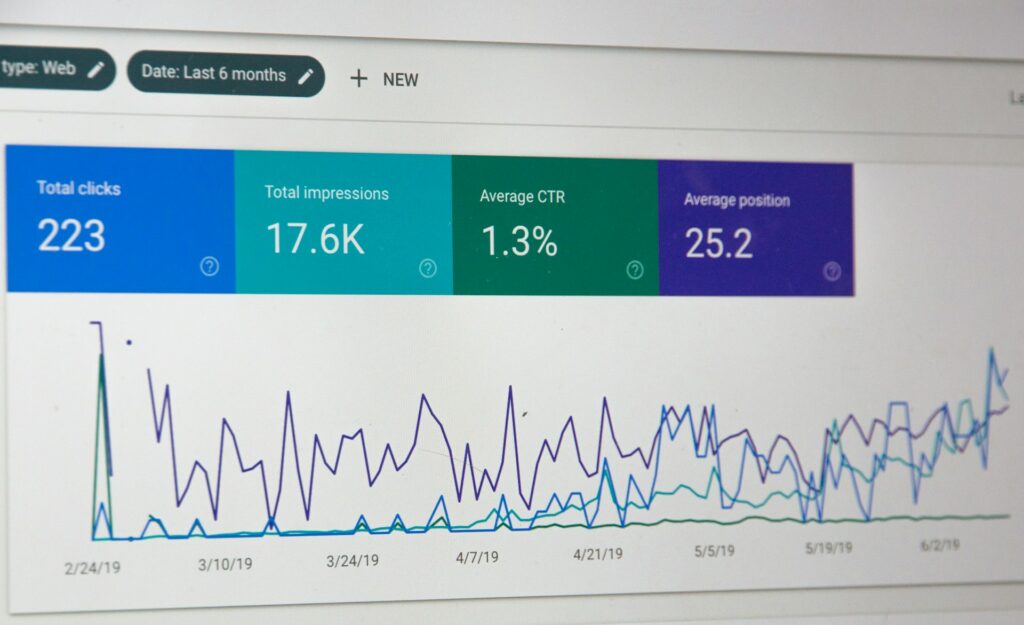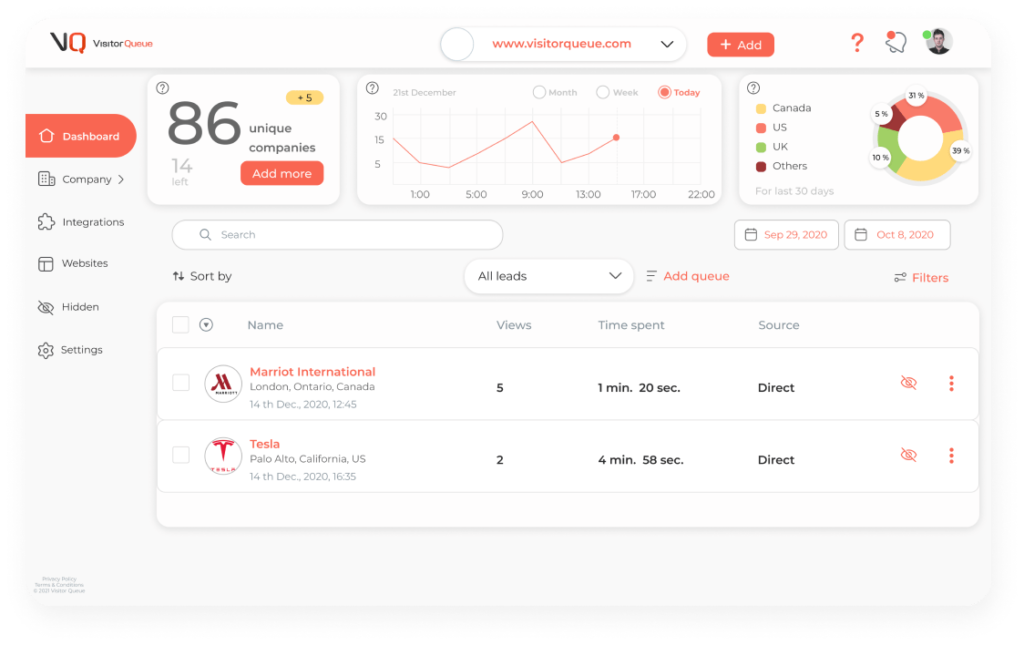Despite their importance, only 23% of marketers are confident that they track the right KPIs. Because of this, it can be difficult to know if your marketing is working to the best of its ability or not. And, if you’re not tracking the right KPIs, it’s almost impossible to make any improvements to your campaigns. In this guide, we’re going to go through how you can measure your overall marketing performance, and go into a few key metrics for specific marketing campaigns. First, let’s go over what a sales funnel is and why it’s important.
Understanding the Sales Funnel
Before diving into the specifics of various marketing strategies, it’s crucial to understand your sales funnel. A sales funnel represents the journey a customer takes from the initial discovery of your company all the way to making a purchase. Here are the four main stages of a sales funnel:
- Awareness: Potential customers become aware of your product or service.
- Interest: They express interest in what you offer and seek more information.
- Desire: Prospects evaluate your product or service and compare it with alternatives.
- Action: They make the purchase decision and become customers.
As you can see with the example below, the funnel starts out wide with many prospects being aware of your company. Each step from here gets smaller, reducing the number of prospects at each level. By mapping out your sales funnel, you can identify which stages need more attention. And then in turn, you can tailor your marketing strategies accordingly.
How to Measure the Overall Effectiveness of Marketing
Now that you understand the basics of a sales funnel, let’s go over how to measure the effectiveness of marketing to better understand if your marketing is working.
Set Clear Objectives
Far too often marketers will set objectives that are not aligned with their sales team or overall company objectives. Before you begin a new marketing campaign, start by defining clear measurable goals. A good rule of thumb to follow is creating SMART goals. This means that your goals are specific, measurable, achievable, relevant, and time-bound. By setting SMART goals, your team will know exactly what they have to do to accomplish the goal.
Track KPIs
With any type of marketing, you’ll need to identify the most relevant KPIs that align with the goals that you’ve set. These might include metrics like website traffic, customer acquisition cost, customer lifetime value, or return on investment. The KPIs that you choose should align with the marketing strategy that you implement. There isn’t a one size fits all approach to tracking your KPIs.
Use Analytics Tools
Without the help of analytics tools, it can be very difficult to track the effectiveness of marketing initiatives. Leverage analytics tools to gather data and gain insights into your marketing performance. Tools like Google Analytics, HubSpot, Visitor Queue, and SEMRush can help you track and analyze your marketing metrics. Take a look at this article, 10 Best Website Analytics Software to Leverage in 2024 to find out what software is best for your needs.

Conduct A/B Testing
A/B testing involves comparing two versions of a campaign to see which one is the most effective. For example, if you have a landing page with a CTA on it, you could change where the CTA is on the page. Then, after some time goes by, you can compare which version of the landing page had more quality conversions. By conducting A/B testing, you can optimize your marketing efforts and improve their effectiveness.
Types of Marketing and How to Measure Their Effectiveness
Now that you know general measurement strategies, let’s go over types of marketing and how to measure their specific effectiveness.
Content Marketing
Content marketing is a fairly broad term, including blog posts, videos, infographics, podcasts, and more. The goal of content marketing is to create and share valuable, relevant content to attract your target audience. Content marketing typically focuses on the top of your funnel, targeting pain points of your audience. Here are the top metrics that you should consider when content marketing:
- Website Traffic: Monitor the number of visitors to your site. Tools like Google Analytics and Visitor Queue can help track this.
- Engagement Metrics: Look at time spent on pages, bounce rate, and social shares. This can help you gauge whether or not your content is resonating with your audience.
- Lead Generation: Measure the number of leads generated through forms, downloads, and subscriptions.
- Conversion Rates: Track the percentage of visitors who take the desired action, such as signing up for a newsletter or making a purchase.
- SEO Performance: Assess your content’s ranking on search engines for targeted keywords. If you need help with tracking your SEO performance, SEMRush is a great tool that is very user friendly.

Organic Social Media
Organic social media with platforms like LinkedIn, Twitter/X, and Instagram are a great way to connect with your audience. In addition, leveraging social media can help build your brand reputation, form more personal relationships, and showcase what you have to offer. When you post on social media, ensure that you share a variety of content to keep your audience engaged. Below are some examples of metrics to measure your social media effectiveness:
- Follower Growth: Track the increase in followers over time. This can help you compare how your content is doing compared to your competitors.
- Engagement Rates: Measure likes, comments, shares, and retweets. By measuring engagement, you can see what your followers respond the best to, and what you should prioritize.
- Click-Through Rates (CTR): Monitor the percentage of users who click on links in your social media posts.
- Reach and Impressions: Assess how many people see your content and how often it appears.
- Conversion Rates: Evaluate the number of social media visitors who complete a desired action on your website.
Email Marketing
Email marketing involves sending targeted emails to your subscribers to nurture relationships. Without a doubt, email marketing is one of the most effective ways to target your audience, and deliver content that they will need when they need it. Whether you’re building newsletters or multi-step drip campaigns, email marketing is a great way to connect with your audience. Here are a few of the key metrics to measure:
- Open Rates: This is the percentage of recipients who open your email. Open rates typically correspond with how enticing your subject line is.
- Click-Through Rates (CTR): The percentage of recipients who click on links within your email.
- Bounce Rates: The percentage of emails that were not delivered successfully.
- Unsubscribe Rates: The percentage of subscribers who opt-out of your email list. If you have a high unsubscribe rate, try to make your content higher quality and less sales-centric.
- Conversion Rates: The percentage of email recipients who take the desired action, such as making a purchase or signing up for a free trial.
Search Engine Optimization
Search engine optimization, or SEO, is the process of optimizing your website to rank higher in search engine results pages to increase organic traffic. This could include creating content like blog articles and landing pages, improving technical SEO, off-page SEO, and much more. Here are a few of the key metrics that you should consider:
- Organic Traffic: Monitor the number of visitors coming from search engines. This can help you set targets for new content and ensure your organic position is continually improving.
- Keyword Rankings: Track the position of your targeted keywords in search engine results. Tools like SEMRush can help you track what keywords you are ranking for, new keywords, lost keywords, and even how your competitors are ranking.
- Backlinks: Evaluate the number and quality of external websites linking to your content. Backlinks can help your website look more reputable to Google, boosting your authority score.
- Bounce Rate: Measure the percentage of visitors who leave your site after viewing only one page. A high bounce rate can mean your content is not high enough quality or attracting the wrong audience.
- Conversion Rates: Assess how well your organic traffic converts into leads or sales.
Search Engine Marketing
On the other hand, search engine marketing is when you pay to be the top result on SERPs. This can help get your brand to the top of highly competitive search results, resulting in more clicks than organic results. Here are the key metrics to know if your marketing is working:
- Click-Through Rates (CTR): The percentage of people who click on your ad after seeing it. A high click through rate would mean that your ad is being clicked on a lot, while a low click through rate would mean that your ad could use some improvements.
- Cost Per Click (CPC): The amount you pay for each click on your ad. You want to ensure your CPC is lower than how much you would make from a sale.
- Conversion Rates: The percentage of clicks that result in a desired action.
- Return on Ad Spend (ROAS): The revenue generated for every dollar spent on ads.
- Quality Score: A metric used by search engines to measure the relevance and quality of your ads and keywords. Keep in mind that Google is a business, and taking all of the recommendations may lead to spending more money than you necessarily need to. Take the quality score recommendations with a grain of salt.
Direct Mail Marketing
Direct mail marketing involves sending physical mail, like postcards, catalogs, flyers, or letters to potential customers. Depending on the industry, direct mail can be a great option for companies to get in front of their audience. While direct mail can be tricky to monitor, here are a few of the key metrics that you are able to measure:
- Response Rates: This is the percentage of recipients who respond to your direct mail campaign. It can be helpful to include a promo code or something that would make it easier to track than the lead physically telling your team.
- Cost Per Acquisition (CPA): The cost associated with acquiring a customer through direct mail.
- Return on Investment (ROI): The overall profitability of your direct mail campaign.
- Lifetime Value (LTV): The long-term value of customers acquired through direct mail.
Identify Your Website Visitors
With the help of Visitor Queue, you can identify the companies that visit your website, along with how they were acquired, what pages they visited, and how long they spent on each page. This can help you see if your marketing is working, because you can see if you’re attracting companies that are in your ideal customer profile. Additionally, our software can also provide employee contact information for the companies to help you reach out. Not to mention, our new benchmarking feature allows you to compare your website metrics against industry standards. Try Visitor Queue for free to better understand your website visitors and generate leads.

Final Words
As you can see, there is a lot that goes into knowing if your marketing is working or not. It’s important to align your goals and expectations with the type of marketing you are looking to do. And, properly monitor the metrics that best align with your goals and the strategy. It can take some trial and error to figure out what your audience responds best to, so if you don’t meet your goal the first time around, try to re-adjust and go from there. If you have any questions about using Visitor Queue to help you understand if your marketing is working and generate leads, do not hesitate to contact our team.
 Identify
Identify Personalize
Personalize Benchmark
Benchmark Agencies
Agencies Integrations
Integrations Case Studies
Case Studies Use Cases
Use Cases Blog
Blog Resources
Resources








